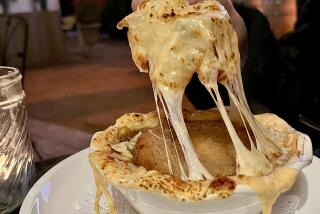The Ware and Tear of Formal Dining
- Share via
Here’s something your mother probably never warned you about: sauce knives. Looking like a flattened-out spoon, this tricky little utensil--also called a sauce spoon--sits with other knives on the right side of the plate, in wait to help drizzle sauce on, say, a bite of salmon that you’ve secured on your fish fork.
If you can’t tell a fish fork from a pitchfork, take comfort in the fact that even the most cultured among us occasionally get flummoxed by an elegant table setting.
“Escargot clamps can be very challenging,” says Sean Loeffel, director of food and beverage at the Four Seasons Hotel, recalling the scene in “Pretty Woman” in which Julia Roberts accidentally catapults a garlicky mollusk across the room.
“I haven’t used an escargot clamp in probably 15 years,” he admits, “and I suspect there are many diners who would not be familiar with how to use it.”
*
Fortunately, even if you’re sitting down to a nine-course meal, you’ll probably only have to negotiate three courses’ worth of knives, forks and spoons at a time.
“Nine courses of silverware would be frightening, even for the most educated,” says Loeffel. “It also wouldn’t fit on the table. As a general rule, in order not to confuse the guest, servers never put out more than three courses of tableware at a time.”
Even so, as you sit down for that nine-course fete for, say, the queen mother herself, prepare to work your way through some 19 pieces of silverware over the course of the evening--or afternoon, when, according to the Tiffany sterling flatware catalog, you might come upon the afternoon teaspoon, as distinct from the teaspoon, ice cream spoon or coffee spoon.
But wait, there’s more. Those 19 pieces don’t include all the serving silverware shined up to parade past your table. Tiffany lists knives (cheese, bread, butter, cake), spoons (berry, sugar, salt, jelly, vegetable) and forks (lemon, olive and cold meat). Also making an appearance: ladles (gravy, punch and sauce), tongs (sugar, ice, asparagus), servers (flat, cheese, cake and butter) and possibly scissors (for grapes).
“Some chefs have a cunning sense of humor,” says Loeffel, who learned forks and spoons from his parents, who’d take him and his nine siblings out to breakfast--the least expensive restaurant meal--in order to teach table manners. “You’ll have a course where normally you’d use a knife and fork, and now some chefs are starting to serve a spoon with it as well, so the guest doesn’t miss out on the leftover sauce.”
And how would you know to use a spoon with your sauce? When in doubt, watch your host, says Loeffel. “We just did a luncheon where we served a coupe dish [that’s a sort of football-shaped, high-sided bowl for foods with hot sauces] and a spoon with it,” he says. “Everyone had their eye on the host so they knew what to do.”
*
In addition to keeping an eye on your host, other rules of culinary propriety include:
Work from the outside in. What your mother did tell you about silverware still applies. Start with the outside utensil and work your way in. The most common mistake is for diners to get rattled by the number of pieces of flatware and reach instinctively for the utensil closest to the plate. Don’t worry about the forks and spoons placed above your plate. They’re for dessert.
Knives and forks dine together. Even those secure in the knowledge that one should work from the outside in may still find it disconcerting to see seven pieces of silverware at their command. Know that for every fork at your place setting, you’ll also have a corresponding knife to your right. The spoon with the round bowl is most likely for soup (there are, however, different kinds of spoons depending on whether you’re served a cream soup [larger spoon] or bouillon). Pasta is often served with a fork and spoon to work that angel hair into a manageable bite.
Although Loeffel was brought up in the American style of putting the knife down and switching the fork to the right hand after cutting a piece of food, he says it is more correct to hold the knife and fork at the same time, one in each hand, as the Europeans do. “It makes more sense,” he says.
When you’re done with a course, place the knife and fork, handles facing out, at the 3 o’clock position on your plate. This will tell the server that you have finished eating.
*
Covet not thy neighbor’s bread plate. Or water glass. Or coffee cup. The bread plate is always to the left of a place setting. Glassware--water, wine, coffee cups and saucers--is always to the right.
According to Jill Cross, director of catering for the Beverly Hilton Hotel, one of the most common mistakes is for diners at a round table to assume control of the bread plate to their right instead of their rightful bread plate to the left. What happens next might best be termed a dining domino effect as everyone else at the table is forced to take the bread plate to their right. Unless, of course, a diner on the other side of the table has already staked out one to the left, which leaves someone without a bread plate altogether.
Another common dilemma: how to get butter from point A, the butter dish, to point B, your bread. Use the butter knife to retrieve a pat of butter as the dish is passed around the table. Place the butter on your bread plate, return the butter knife to the dish, then use your own knife to spread butter on your bread.
And if you do find yourself drawn into the who’s-got-my-bread-plate controversy, “adjust,” says Loeffel. “It’s not worth anyone getting embarrassed over it. Also, any server worth his weight will notice what’s happening and will adjust for you by bringing new silverware or another bread plate.” At their best, rules of table etiquette are designed for clarity, not one-upmanship. Consider, for example, the story credited to Queen Victoria, who, upon seeing an unsuspecting dinner guest pick up his finger bowl and drink from it, raised her own finger bowl to her lips and also drank. Taking her lead, the rest of the guests joined her.
And they all lived happily, perhaps not ever after, but at least through the dessert course.
More to Read
Eat your way across L.A.
Get our weekly Tasting Notes newsletter for reviews, news and more.
You may occasionally receive promotional content from the Los Angeles Times.







